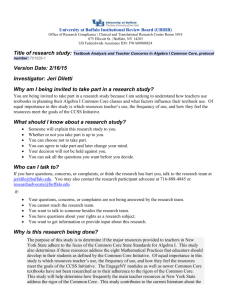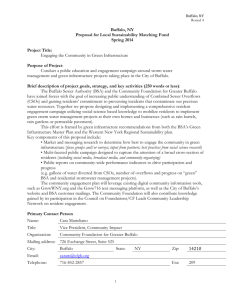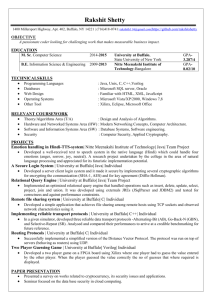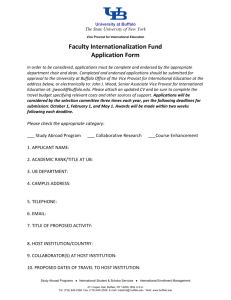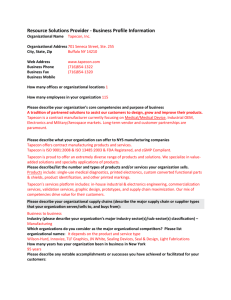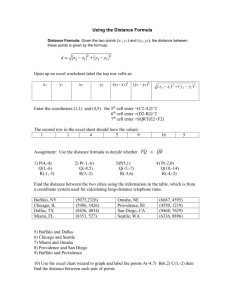IEFA Infusion Lesson
advertisement
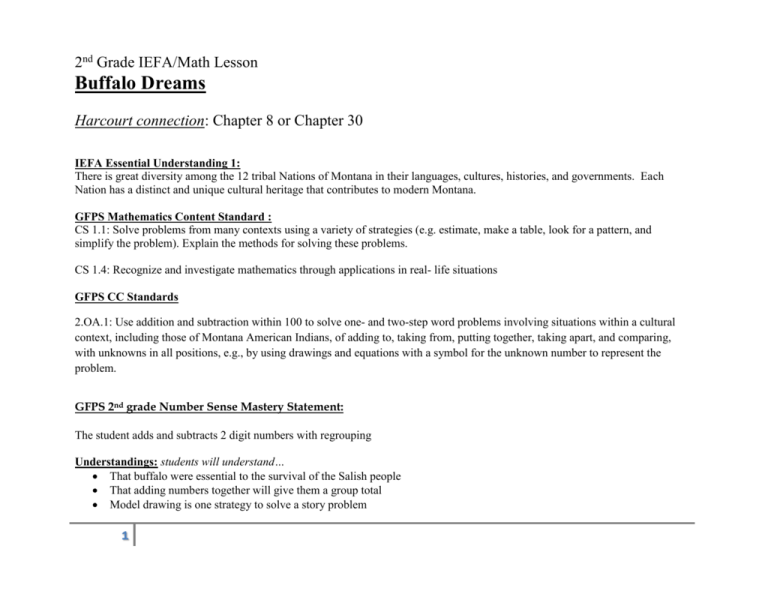
2nd Grade IEFA/Math Lesson Buffalo Dreams Harcourt connection: Chapter 8 or Chapter 30 IEFA Essential Understanding 1: There is great diversity among the 12 tribal Nations of Montana in their languages, cultures, histories, and governments. Each Nation has a distinct and unique cultural heritage that contributes to modern Montana. GFPS Mathematics Content Standard : CS 1.1: Solve problems from many contexts using a variety of strategies (e.g. estimate, make a table, look for a pattern, and simplify the problem). Explain the methods for solving these problems. CS 1.4: Recognize and investigate mathematics through applications in real- life situations GFPS CC Standards 2.OA.1: Use addition and subtraction within 100 to solve one- and two-step word problems involving situations within a cultural context, including those of Montana American Indians, of adding to, taking from, putting together, taking apart, and comparing, with unknowns in all positions, e.g., by using drawings and equations with a symbol for the unknown number to represent the problem. GFPS 2nd grade Number Sense Mastery Statement: The student adds and subtracts 2 digit numbers with regrouping Understandings: students will understand… That buffalo were essential to the survival of the Salish people That adding numbers together will give them a group total Model drawing is one strategy to solve a story problem 1 Essential questions: Why were the buffalo essential to the survival of the Salish people? What does addition do to a number? What do you know about this math problem before you even start to solve it? Students will be able to… Solve a story problem using model drawing Tell how the buffalo helped Salish people survive Students will know… Place Names Allotment Salish Assessment Evidence: Students will solve the story problem Students will tell a neighbor why the disappearance of the buffalo was a problem for the Salish people. 2 Learning Plan Materials Buffalo Dreams Model Drawing handout Map of Montana Gain Attention 1. Show students the video of the Buffalo Runner \\disk\special\teacheritems\drop\IEFA 2. Question: What did you observe in the video? Share with a neighbor. Share out loud. a. This is called a buffalo jump. There is one right in Ulm called the First Peoples Buffalo Jump. How many of you have been there? b. The runners you saw were called buffalo runners. They ran long distances, dressed as buffalo and their job was to run the buffalo off the jump. c. The reason they did this was for their survival: food, clothing, tools, etc. They respected the buffalo and did not waste a single part of it. State Objective and Rationale: Today you will be learning: 1. About the importance of the Buffalo to the Salish Tribe. a. The Salish people relied on buffalo for food and survival. When the buffalo began to disappear, the people worried about surviving. 2. How to use model drawing as a strategy to solve a real-life problem. a. Many story problems can be solved by using model drawing to help you represent the problem first. Build Background 1. Read the story “Buffalo Dreams” by Julie Cajune 2. Pause during the story to insert cultural background as delineated in the attached document. 3. Ask: Why would the buffalo’s disappearance be a problem for the Salish people? 3 Teaching: 1. Go back and highlight the part of the story that talks about how much each of the 10 calves weighed. How many pounds of buffalo were there in that whole herd? 2. Show the model drawing problem. What do you know about this problem before we even start to solve it? (answer will be bigger than 10, etc) 3. Go through the steps of model drawing with the whole group to solve. Use answer frame if needed. What is always true about adding? (answer will be bigger than what you start with, etc) 4. If students need, continue with the extension problem. Perhaps in small groups or individually. Could also do this one whole group. Closure: 1. Tell your neighbor why the disappearance of the buffalo was a problem for the Salish people. 2. Tell your neighbor about model drawing. 4 2nd Grade IEFA Model Drawing Problem Little Hawk Blanket went into camp with 6 buffalo calves. Each calf weighed only 30 pounds. How much did the 6 calves weigh altogether? 1. 2. 3. 4. 5. 6. 7. Read the entire problem. Decide who and what is involved in the problem. Draw unit bar(s) of equal length. Read each sentence, one at a time. Put the question mark in place. Work computation. Answer the question in a complete sentence ___________________________________________________________________________________________________________________ ___________________________________________________________________________________________________________________ _________________________ Extension: If all 10 calves had made it back to camp, how much would they weigh altogether then? 5 6 Mali was returning to her lodge with water for her mother when she spotted the hunters returning. She ran inside and told her mother, Five Horses Woman, that the hunters had returned. Five Horses Woman and Mali went to greet the hunters and find out if they had been lucky. The hunters talked to their relatives that had come to greet them. "We went all the way to Eyes Wide Open Wood River and we only found seven buffalo. We were lucky to find them. The buffalo are disappearing." Mali's heart felt heavy and sad. She wondered how they could find enough meat for the winter that was coming. She looked at her mother and asked, "What about the Buffalo Calling Song? Why don't the buffalo come?" Five Horses Woman remembered when she was a child and the people used the song to bring the buffalo. She told Mali, "Now there are no buffalo to hear." Background about Buffalo Calling Song: Before the horse, plains tribes hunted buffalo differently; all hunting took place on foot. Hunters would lure a herd close to a cliff (buffalo jump) or area where they could be corralled. Young hunters that lured the buffalo were called buffalo runners. Older, select tribal men, performed ceremony to draw the herd in, they would “called” to the buffalo. With the introduction of the horse, buffalo calling became an unnecessary hunting technique. Hawk Blanket recalled how the buffalo used to be like a dark cloud on the prairies and plains. He knew there would never be that many buffalo again. Then he had an idea. He went to the Chiefs lodge to talk about his plan. Four Ravens listened to Hawk Blanket's idea. Hawk Blanket wanted to herd some of the orphan buffalo calves back to the reservation. The people could start their own buffalo herd. Four Ravens and his people had a deep respect for the buffalo and he did not know if it would be right to raise them as the whites did their cattle. He told Hawk Blanket that he would ask the elders. Place Name Background information: Looking at a map of Montana many of the mountains, rivers or other geographic areas reflect history that is tied to European expansion. However, the places found in Montana had names that were in use for thousands of years before European contact. These places were named by the people who had always lived there and used the land. Place names were passed on from generation to generation. Names given might describe resources found in a location, important physical features of the land, or have a connection to tribal oral tradition. All tribal place names reflect a strong knowledge of land, cultural tradition and tribal history. Eyes Wide Open Wood River is also called the Musselshell River. The river is named for the Diamond Willow that grows there. The wood has knots on it that look like eyes do when they are wide open. 7 The elders met for three days talking about Hawk Blanket's idea. They could not find agreement. Hawk Blanket let the idea go. He would not go ahead with the plan without the agreement of his leaders. Weeks and months passed and the buffalo were hardly ever seen. The people were sad and they realized that the buffalo could completely disappear. The chiefs called on Hawk Blanket's son, Little Hawk Blanket. "Do you think you can make the trip to get some orphan buffalo calves? It is a long journey, and you might face danger." Little Hawk Blanket felt honored to go for the calves. "I will go Four Ravens. Thank you for choosing me. I won't let the people down. I will return with buffalo to start a herd." "Going to buffalo" was a way of life for Little Hawk Blanket and his people. The "road to buffalo" was well known. Little Hawk Blanket traveled through the Hell Gate Canyon and headed for buffalo country. His people had made an agreement with the government that they would share their old hunting grounds with other tribes that had moved on to their territory. He rode out onto the plains, to the common hunting grounds. Going to Buffalo: This is a term used to describe the act of going on a buffalo hunt anywhere east of the Continental Divide. Background on Allotment and Common Hunting Grounds: 1851 - The area of Montana known as the Common Hunting Grounds was established through the Ft. Laramie Treaty. This treaty reduced Blackfeet territory by designating the southern end of Blackfeet territory as hunting ground to be used by Cheyenne, Sioux, Arapaho, Navajo, Crow, Shoshone, Assiniboine, Mandan, Hidatsa, and Arikara Indian nations. The Blackfeet nation was not present at this treaty making. 1855 – The Lame Bull Treaty (also known as: Yellowstone Treaty or Blackfoot Treaty) brought the Blackfeet people to the table to address the issue of the common hunting ground. The tribes all agreed to live in peace with one another and the Blackfeet agreed to share the land for 99 years. See page 11 for more information. Allotment on the Flathead Reservation 8 The Dawes Act of 1887 hit Flathead Reservation in 1904. The purpose was to open up lands within the When he arrived at Eyes Wide Open Wood River he made camp. Little Hawk Blanket prayed in the morning, "Creator, have pity on your people. Show me where to look for the orphan calves." Each day he would ride out from camp, looking for signs of the buffalo. On the fourth day he was lucky! He found tracks and some chips that were still fresh. He knew the buffalo had been there yesterday. Traveling north along the river, he spotted a small herd. When the herd smelled him they stampeded. He was able to catch 10 calves left behind. The calves looked like they would be heavy, but they were light as a feather. 9 They only weighed 30 pounds. They were all hair. They had not had much food. At the camp, Mali worked all day tanning a hide with her mother. It was hard work! She knew she was going to sleep deeply that night. "Thank you for your good help today daughter," Five Horses Woman said to Mali. Mali smiled at her mother. It felt good to have her mother's approval. That night Mali dreamed of buffalo. Hundreds- thousands were moving across the hills like smoke. Today is called the Clark Fork River Little Hawk Blanket made it to Uncertain Waters River and camped. The journey was hard for the little calves. Some of them got away. Some died. Little Hawk Blanket wondered if he would make it home with the calves. He prayed again, asking for help to get the little calves home to the reservation. Five Horses Woman filled the wooden bowl with deer meat and bannock. She stepped outside and started for her grandparents' lodge. In the distance she could see a rider on horseback in a little cloud of dust. She stopped to see what was causing the cloud of dust around him. "Mali," she shouted. "Mali, come see what is coming to our camp!" Bannock is a form of bread that was introduced to American Indian people through European contact. It’s flat, heavy bread that was baked over an open fire, but is now baked in the oven. 10 Mali ran out of the lodge to her mother and looked to the east. "Mother, what is chasing the rider?" "It is our orphans come home. It is the buffalo come back to the people." Little Hawk Blanket rode into camp with six orphan buffalo calves. His prayers and the dreams of the people had come true. Historic Background This is a short account of how the Pend d'Oreille saved the buffalo. Some of the details in the story have been fictionalized, but the basic story line is true. Hawk Blanket, a Pend d'Oreille, did propose the idea to start a buffalo herd. When the people could not agree on the plan, he let his idea go. His son, Little Hawk Blanket was allowed later to go find some orphaned calves. He made it back to the reservation with about six. This herd was later sold to Michel Pablo and Charles Allard. Allard was a member of the Confederated Salish and Kootenai Tribes. Michel Pablo was married to a tribal member. The herd was ranged along the Lower Flathead River and it flourished and grew into the hundreds. Some of the herd was sold to the Conrad family in Kalispell, some to Howard Eaton who later sold them to Yellowstone Park. When the Flathead Allotment Act divided Flathead Indian Reservation lands up in 1904, Michel Pablo was forced to sell the herd. Charles Allard had died in 1896. Allotment broke up the large communal grazing lands that tribal members were also using for cattle and horses. By 1908 over 690 buffalo had been rounded up and shipped to Alberta, Canada. In 1909, Congress was persuaded to take some 18,000 acres of Flathead Indian Reservation lands to create a National Bison Range. The government purchased some of the buffalo that Pablo sold to the Canadian government. And so it was that portions of the Pablo-Allard herd returned to the Flathead Indian Reservation. The descendants of the six-orphaned calves came home, again. More about Common Hunting Grounds and Allotment: The Dawes Act of 1887 hit Flathead Reservation in 1904. The purpose was to open up lands within the reservation to nonIndian homesteading. Enrolled tribal members were allocated tracts of land of either 80 acres of farmland or 160 acres of grazing land. Any remaining land was then designated as surplus and sold to European settlers starting in 1910. Between 1910 and 1929, over 400,000 acres of land was made available for homesteaders. As a result of this legislation, the Confederated Salish and Kootenai Tribes became the minority population on their own reservation. 11 12

